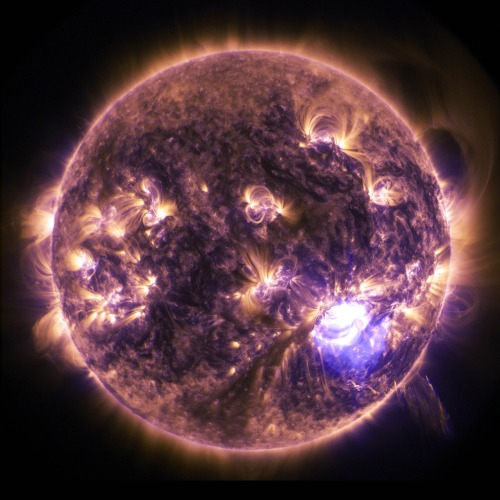anaceinspace-blog
I post asexual stuff and space stuff. ADMIN APPLICATIONS ARE OPEN CHECK NAVIGATION FOR LINK TO THE APPLICATION. Profile pic credits to mochakimono.tumblr.com
100 posts
Latest Posts by anaceinspace-blog


♥ Asexuals and Aromantics are valid and deserve our respect, without our questioning ♥

Mauna Kea Starlight
js

The Glow Through the Trees, Australia
js

NASAs Solar Dynamics Observatory captured this image of a significant solar flare as seen in the bright flash on the right on Dec. 19, 2014. The image shows a subset of extreme ultraviolet light that highlights the extremely hot material in flares
js

30 Doradus, located in the heart of the Tarantula nebula, is the brightest star-forming region in our galactic neighborhood. The nebula resides 170,000 light-years away in the Large Magellanic Cloud.
js

Milky way over Tre Cime Di Lavaredo by Luca Cruciani
js

Galactic Standstill Lake Tenaya, California
js

Me staring at the Milky Way and Aurora Australis
js

Milky Way over Spencer Bay, Moosehead Lake, Maine
js
Things You Might Not Know About Our Sun

The sun is a star, a hot ball of glowing gases at the heart of our solar system. Its influence extends far beyond the orbits of distant Neptune and Pluto. Without the sun’s intense energy and heat, there would be no life on Earth. And though it is special to us, there are billions of stars like our sun scattered across the Milky Way galaxy.

Impress Your Friends with These Sun Facts:
If the sun were as tall as a typical front door, the Earth would be the size of a U.S. nickel
The temperature at the sun’s core is about 27 million degrees Fahrenheit
Our sun is more massive than the average star in its neighborhood. Nearly 90% of stars are less massive, making them cooler and dimmer
The sun contains 99.9% of all matter in our solar system
During a single second, the sun converts 4 million tons of matter to pure energy
It would take about 1 million Earths to fill the sun if it were a hollow ball
The sun rotates on its axis approximately once every 27 days
The sun is 93 million miles away from Earth and is almost 5 billion years old
Make sure to follow us on Tumblr for your regular dose of space: http://nasa.tumblr.com

Grand Canyon National Park, Arizona, USA. Photographer: Deryk Baumgrtner
js
7 Things That Happen When You Go To Space
Told Through Astronaut Scott Kelly’s Tweets
Astronaut Scott Kelly is currently spending a year in space. Most expeditions to the space station last four to six months. By doubling the length of this mission, researchers hope to better understand how the human body reacts and adapts to long-duration spaceflight. During this one-year mission, Kelly is also participating in the Twins Study. While Kelly is in space, his identical twin brother, retired NASA Astronaut Mark Kelly, will participate in a number of comparative genetic studies.
Here are a few things that happen when astronauts go to the space station:
1. Your personal hygiene takes on a different form:


2. Sleeping arrangements might take some getting used to:



3. Internet services will remind you of the 90s:

4. You never have to do laundry:


5. You get to become immersed in a range of different cultures:

6. All of your water is recycled…yes…that means urine too:


7. You get to see the Earth like never before:



Follow Astronaut Scott Kelly’s Year in Space mission on Facebook, Twitter and Instagram.
Make sure to follow us on Tumblr for your regular dose of space: http://nasa.tumblr.com
Ten Awe-Inspiring Photos
We’ve taken 10 of our top Instagram posts and put them here for your viewing pleasure. Now, your next 10 cell phone backgrounds can be found in one place.
10. Water on Mars

With 210,000 likes, this image is a favorite on Instagram. New findings from our Mars Reconnaissance Orbiter (MRO) provide the strongest evidence yet that liquid water flows intermittently on present-day Mars. Dark, narrow streaks on Martian slopes such as these at Hale Crater are inferred to be formed by seasonal flow of water on contemporary Mars. The streaks are roughly the length of a football field.
9. Smoke Ring for a Halo

With 210,000 likes, this image shined on Instagram. Two stars shine through the center of a ring of cascading dust in this image taken by the Hubble Space Telescope. The star system is named DI Cha, and while only two stars are apparent, it is actually a quadruple system containing two sets of binary stars. As this is a relatively young star system it is surrounded by dust.
8. Pluto’s Largest Moon, Charon

With 216,000 likes, a lot of people thought this image was interesting on Instagram. Our New Horizons spacecraft has returned the best color and the highest resolution images yet of Pluto’s largest moon, Charon - and these pictures show a surprisingly complex and violent history. This high-resolution enhanced color view of Charon was captured just before closest approach on July 14. The image combines blue, red and infrared images; the colors are processed to best highlight the variation of surface properties across Charon.
7. Veil Nebula

With 220,000 likes, many people favorited this image on Instagram. This is the expanding remains of a massive star that exploded about 8,000 years ago. This view is a mosaic of six pictures from our Hubble Space Telescope of a small area roughly two light-years across, covering only a tiny fraction of the nebula’s vast structure. This close-up look unveils wisps of gas, which are all that remain of what was once a star 20 times more massive than our sun.
6. Messier 94 Galaxy

With 234,000 likes, this image is a favorite on Instagram. This image shows the galaxy Messier 94, which lies in the small northern constellation of the Hunting Dogs, about 16 million light-years away. Within the bright ring or starburst ring around Messier 94, new stars are forming at a high rate and many young, bright stars are present within it.
5. Solar ‘Pumpkin’

With 247,000 likes, many followers enjoyed this image on Instagram. This photo was posted on Halloween and shows active regions on the sun combined to look something like a jack-o-lantern’s face. The image was captured by NASA’s Solar Dynamics Observatory in October 2014, which watches the sun at all times from its orbit in space.
4. Italy from the International Space Station

With 251,000 likes, this image captivated many of you on Instagram. Before drifting off to sleep, NASA astronaut Scott Kelly (@stationcdrkelly) captured this images from the International Space Station and wrote, “ Day 180. Moonlight over Italy. #BuonaNotte Good night from @ISS! #YearInSpace.”
3. Cosmic Archaeological Dig

With 286,000 likes, this image dazzled many of you on Instagram. Peering deep into the Milky Way’s crowded central hub of stars, researchers using our Hubble Space Telescope have uncovered for the first time a population of ancient white dwarfs – smoldering remnants of once-vibrant stars that inhabited the core. Finding these relics at last can yield clues to how our galaxy was built, long before Earth and our sun formed. This image is a small section of Hubble’s view of the dense collection of stars crammed together in the galactic bulge.
2. Super Blood Moon

With 310,000 likes, this image was very popular on Instagram. It shows the Super Blood Moon behind the Washington Monument on Sunday, Sept. 27, in Washington, DC. The combination of a supermoon and total lunar eclipse last occurred in 1982 and will not happen again until 2033.
1. Pluto

With 363,000 likes, this image is one of our most popular pictures on Instagram. The dwarf planet sent a love note back to Earth via our New Horizons spacecraft, which traveled more than 9 years and 3+ billion miles. This was the last and most detailed image of Pluto sent to Earth before the moment of closest approach, which was at 7:49 a.m. EDT Tuesday, July 14 - about 7,750 miles above the surface – roughly the same distance from New York to Mumbai, India - making it the first-ever space mission to explore a world so far from Earth.
For more pictures like these, follow us on Instagram: https://www.instagram.com/nasa/
Make sure to follow us on Tumblr for your regular dose of space: http://nasa.tumblr.com

Appearing like a winged creature poised on a pedestal, this object is actually a billowing tower of cold gas and dust rising from a stellar nursery called the Eagle Nebula. The soaring tower is 9.5 light-years high, about twice the distance from our Sun to the next nearest star
js
What’s a Space Headache?
Headaches can be a common complaint during spaceflight. The Space Headaches experiment improves our understanding of such conditions, which helps in the development of methods to alleviate associated symptoms, and improve the well-being and performance of crew members in orbit. This can also improve our knowledge of similar conditions on Earth.























